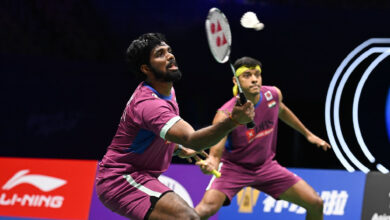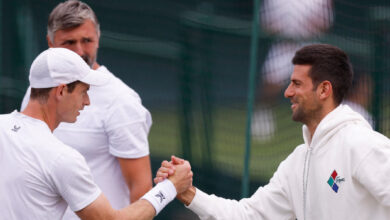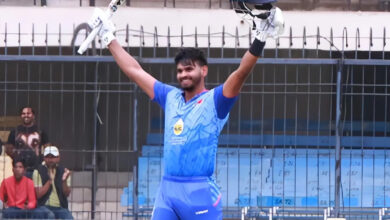Tendulkar vs Warne: The told and untold stories about cricket’s greatest battle

Hory is written the victors, it is said, but in sport, the autobiographies of the vanquished get read too.
Sachin Tendulkar’s methodical dismantling of Shane Warne during the 1998 season is no folklore. It is a well-documented story that has insight, and also intrigue. At a time when Warne’s laudatory obituaries have needlessly side-stepped his underperformance on those India tours or airbrushed the reasons for it, the iconic contest needs what movie-makers say a Rashomon treatment – different interpretations of the same event the individuals involved.
When excerpts from the biographies of Tendulkar and Warne mutate, an unheard version of one of Indian cricket’s favourite cricketing tales is born. Disclaimer: Warne, his own admission, ended second-best to Tendulkar, who was in the form of his life. But like always, the greatest leg-spinner with the biggest heart never gave up.
India loves to talk about Tendulkar’s preparation for that Test series, him facing Laxman Sivaramakrishnan on scuffed-up pitches, those against-the-turn sixes in Chennai, and the Sharjah Desert Storm a month later. But there’s no mention of Warne’s dodgy shoulder and a depleted Aussie bowling attack.
Dig more and one unearths a lesser-known eyewitness account of an insider to give a final tw to the face-off that Tendulkar has called the “most intense of his career”. Saving the curator’s googly to the world’s most famous leggie for the last, first a primer.
***
On that 1998 tour to India, hyped as the title fight with Tendulkar, Warne didn’t get what he wanted. Not even a simple toasted cheese sandwich.
Early on that trip, the team hotel’s eager-to-please room service staff stuffed the breads with ham, tomato and onions, even when the Aussie star’s order clearly mentioned ‘just cheese’. After Warne sent it back, it would arrive minus the tomatoes. Rejected again, the waiter still couldn’t get it right. There was cheese, but ham too. “I tell you what, mate, I’ll have a plate of French fries,” Warne would write in his autobiography No Spin.
On the central square, on match days, Warne would even be denied fries. Tendulkar, to the delight of a delirious nation, hogged the happy meal.
It was an era when cricket, officially a team sport, got into the habit of moonlighting as an individual gladiatorial contest too. Tendulkar, Warne, Brian Lara and Muttiah Muralitharan had it in them to reduce the 20 others on the field to props. They had charisma and the gravitas to make their own sub-plot more relevant than the main storyline. Those were times when Indian fans would be going home singing, dancing and celebrating a Tendulkar hundred, even if India had lost the game.
Any combination of these four superstars pitted against each other would guarantee packed stands and TRPs, but still Warne vs Tendulkar remained the big-ticket event. They represented two passionate cricket nations, both blessed with vibrant economies.
The 1998 Goliath vs Goliath cricketing clash had the hype of Rumble in the Jungle. Never ever had a series, or rather an individual battle, mattered so much to so many.
Those were the exciting 90s, the benefits of liberalisation were finally trickling down to Indian cricketers towards the second half of the decade. In 1995, Ravi Shastri would introduce Tendulkar to one Mark Mascarenhas, a visionary agent wise enough to understand that players were brands around whom a sport could grow. Long before Lalit Modi, it was he who added those extra zeros to the Indian cricketers’ commercial contracts.
India would wake up to the business of sports, even the middle-class warmed up to cricket being a career option. Millions of IIT-MBA-obsessed Indian parents would spill their morning tea when they read the headlines about Tendulkar signing a Rs 30 crore deal with Mascarenhas’ WorldTel. Teachers would become less cynical towards kids bunking classes for cricket.
In 1998, a lot was riding on Tendulkar. Mascarenhas, Indian cricket, parents, teachers and kids had their fingers crossed. Would Tendulkar justify India’s collective leap of faith? Warne’s wizardry could break the spell, shatter the dream. This was an unfamiliar script, the spin magician, for once, was a blonde white boy.
It proved to be a battle for the ages. Till date, sports channels keep playing reruns. First in Tests and later that Desert Storm ODIs in Sharjah – games tattooed on the nation’s collective retina forever – Tendulkar demystified Warne. That March-April of 1998, those dreaded school exam months nationally, the Tendulkar legend grew. Grapevine has it that across the country, there was a collective dip of marks that year.
It was the series that made Tendulkar the Greatest, and also the Richest. In 1999, Don Bradman would invite both Warne and Tendulkar to his Adelaide home and declare to the world that the Indian star reminded him of his playing days. It was as if a whip had been issued, every living Aussie turned into a bona fide Tendulkar fan overnight. On conquering Warne, Tendulkar attained sainthood. Mascarenhas kept adding zeroes, the Tendulkar deal was now worth Rs 100 crore. Indian cricket had changed forever, all because of Tendulkar, and also Warne.
In 1999, Don Bradman would invite both Warne and Tendulkar to his Adelaide home and declare to the world that the Indian star reminded him of his playing days. (Twitter)
***
Players like Tendulkar never leave things for late or to chance. Literally every blade of grass is factored in before they enter the ground to take guard. There’s this famous story of Tendulkar walking into the dressing room on the eve of the India-Pakan 2003 World Cup game after a slow circle around the Centurion ground. He would mention observing the blades of the grass pointing towards the pitch around third-man. His inference: “I can run two running the ball past the slips”. There’s a reason he finished with hundred 100s.
To face Warne, Tendulkar came up with a strategy, as he mentioned in his autobiography Playing It My Way. “Warne’s biggest strength was the drift he managed to get, which meant that the batsman was somewhat blinded the delivery if he was batting with a traditional side-on stance. Because of the extra drift, the ball would tend to go away from the vision of the batsman. I decided to open my stance a little to Warne and to stand slightly outside the leg-stump. I also planned to play him from the crease and as late as possible. I hardly stepped out to him all series and, more often than not, kept hitting him towards mid-wicket with a horizontal bat whenever he tried to extract extra spin from the leg-stump or slightly outside. playing from the crease and using the horizontal bat, I reckoned I had opened up the option of punishing him if he bowled short and could also play the cut shot on the off-side.”
To face Warne, Tendulkar came up with a strategy, as he mentioned in his autobiography Playing It My Way. (Twitter)
Tendulkar would ask for the best spinners available in Mumbai and ask them to bowl from round the wicket, aiming for the artificially-created rough outside leg-stump. First, he would train with leggie Sairaj Bahutule and left-arm spinner Nilesh Kulkarni. Later in Chennai, the venue for the first Test, he would ask the almost-retired Siva to put on his whites and bowl those big leg-spinners that drifted out and climbed on to the legs. the time the Aussies came, Tendulkar writes: “I felt ready to face Warne”.
He would be part of India’s reception party, leading Mumbai for the opening tour game. Tendulkar’s instruction to his Mumbai mates was unambiguous. “Attack Warne” was the plan. At the maidans, they still recall the game and opener Amit Pagnis. “Amit pehle haath chhoda (Amit attacked first)” – the tapori street fight lingo overlaps cricket talk in Mumbai. He hit four 4s in Warne’s first two overs. Tendulkar’s ‘hello’ to his dear friend was in the form of a six in his first over. Warne ended up conceding 111 runs in 16 overs in that game, India couldn’t wait for the first Test in Chennai.
***
In the first innings of the Chennai Test, Tendulkar would get out early. Caught skipper Mark Taylor off Warne for 4 while driving the ball. So in the second innings, when Tendulkar walked in, Taylor took his position behind the stumps and threw the ball to his main weapon.
Australia’s celebrated cricket writer Gideon Haigh, in his book On Warne, narrates what he calls a “drool story” that Taylor loves repeating after dinner talks. It’s about a particular over when Tendulkar challenged Warne. It was the moment of truth that made him the Phenomenon. It was also a seminal moment in Indian cricket.
“In the second innings, naturally enough, he (Taylor) threw the ball to Warne as soon as Tendulkar appeared. Tendulkar smashed a straight boundary. Warne came round the wicket. Tendulkar hit inside-out over cover to the boundary. Warne came round the wicket again. Tendulkar hit over mid-wicket into the stands. As they passed mid-pitch at the over’s completion, Taylor was eager to hear what Australia’s great champion had in store for India’s champion next.
‘Tubs,’ said Warne matter-of-factly, ‘we’re stuffed’.”
Tendulkar remains typically restrained in describing his epic knock. He doesn’t drag his description about his assault on Warne. (Express File Photo)
Moving to Warne’s autobiography to check how he recalled the same incident. Did he actually say, ‘we’re stuffed’? No, he didn’t. Warne was more graphic.
Excerpt from No Spin: “In the second innings, Mark Taylor brought me on as soon as Sachin came in and I quickly switched to bowl round the wicket and into the rough. He slogged the third ball into the stands at mid-wicket for six and just carried on from there, like a man possessed. After a few overs of this, Tub asked what I thought. ‘I think we’re f*&ked,’ I replied.”
Tendulkar remains typically restrained in describing his epic knock. He doesn’t drag his description about his assault on Warne. “As expected, Shane Warne started to bowl round the wicket and I instantly took the attack to him and hit him over midwicket. From an individual perspective, it was a defining moment in the game. We couldn’t afford to lose.”
Later in the book, he talks about the gratification of his successful warfare. “It was one of the most intense series I played in my career, and one of the most personally successful. I had scored close to 450 runs at an average of 111. Weeks of rigorous practice had paid off and it was a deeply satisfying feeling.”
Warne too gave a respectful bow to his long-time adversary. “Sachin was the best judge of length I played against – he was unbelievable in India on the ’98 tour – and very quick on his feet. He got down the pitch easily and could sweep well too, so the margins for error from my point of view were very small.”
***
Now, the grey area that rarely gets discussed in India.
Warne’s No Spin talks about his injury and the scary conversation he had with his doctor after the Test series in India and the Sharjah ODI tournament. “Your shoulder is hanging a thread, mate. I don’t know how you put up with the pain,” the doctor would tell Warne.
All through the series, he struggled but still let the ball rip. The shoulders didn’t cooperate but those famously big fleshy fingers and ever-ticking brain was working overtime.
“As the series went on, I struggled to get my arm high enough to release the ball from anywhere near the right position. The headaches were unbelievable, I struggled with sleep and was hardly able to train – in short, I was struggling and in pain … After Sharjah, where Sachin smacked us again and won every award on earth, the first thing I did on return to Australia was to go and see Greg Hoy, who’d done the operation on my finger. The MRI scan wasn’t good. ‘Len, you might be lucky,’ he told me. ‘Another few months and, who knows, it might have been too late …”
It was a jinxed tour for Australia, Warne didn’t have much support from the other end either. “We had a pretty ordinary attack. (Glenn) McGrath was injured, Jason Gillespie too, and Paul Reiffel only played the first Test before breaking down. The bulk of the quick bowling came from Michael Kasprowicz. Paul Wilson and Adam Dale were in the squad but, no disrespect, were both a fraction short of Test class in those conditions; then we had the Waugh brothers, Greg Blewett and Gavin Robertson, who was the other spinner. Hey, this was Tendulkar and co! We were kind of clinging on every day,” wrote Warne.
At the launch of his book, former England captain and accomplished cricket writer Michael Atherton started the interview with a trivia that he was pained to read. “Page 144, Warne says he was at his peak from 1993 to 1998, before his shoulder injury.” Those were the exact years of his England captaincy. It’s a shame that when Tendulkar was at his best, Warne wasn’t. In 1999, Australia would even drop him from the playing XI once.
***
POSTSCRIPT:
Exactly 15 years after that Chennai game, there was another India-Australia game at the same venue. After the game that MS Dhoni’s India won on a pitch that had different shades of brown, MA Chidambaram Stadium’s curator for close to four decades K Parthasarathy sat on a chair in front of his shed beyond the boundary line. He had a smile on his face and was in a mood to talk.
It was a game where the Indian spinners had taken 20 wickets but the expected chorus of criticism from the visiting team, a ritual for ages, was missing. Parthasarathy revealed how he cracked the code. “We started making the entire pitch firm. After that, we watered it selectively. The areas on either side of the stumps were kept dry, and so turned out to be loose. The line of the stumps was watered and rolled, so it stayed firm through the Test,” he says.
So the Aussie pacers who concentrated on the line of the stumps, hoping that the wear and tear would give them uneven bounce and thus LBW or bowled dismissals, failed. The spinners from both the teams enjoyed the natural variation that the rough spots on the loose soil provided. “If I had kept the entire pitch dry, people would have called it under-prepared. But now nobody is complaining,” said Parthasarathy.
It was then that he shared a secret of the 1998 game in which Tendulkar scored a hundred, Warne went for 1/122 and India won the first match of that series 179 runs. “I kept the square patches outside the leg stump, on either side of the wicket, really hard. It was difficult to get turn from that part as there would be no rough there,” he says. “After that game, Warne came to me and asked why he wasn’t getting the turn and others were. I told him it was because of his dodgy shoulder, that was to be operated on later in the series.”







